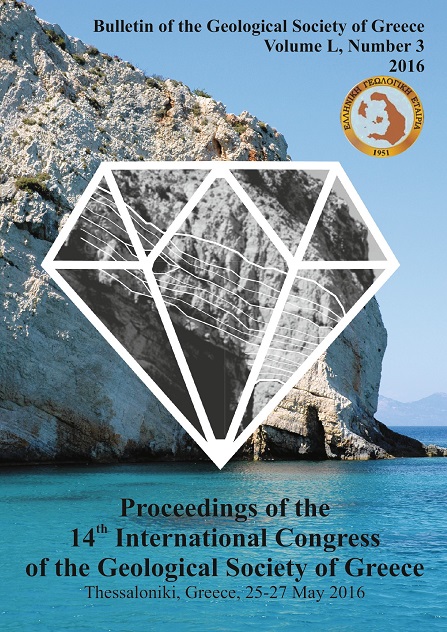SEISMIC HAZARD ASSESSMENT IN THE NORTH AEGEAN TROUGH BASED ON A NEW SEISMOGENIC ZONATION

Περίληψη
Η ποσοτικοποίηση των αβεβαιοτήτων και η επιλογή του μοντέλου σεισμογενών ζωνών αποτελούν κρίσιμα σημεία στην πιθανολογική εκτίμηση της σεισμικής επικινδυνότητας. Στην παρούσα μελέτη ακολουθήθηκε η δομή ενός “logic tree” από 16 κλάδους: χρησιμοποιήσαμε δύο μοντέλα σεισμογενών ζωνών, ένα νέο μοντέλο για την περιοχή του βορείου Αιγαίου, που βασίστηκε σε πρόσφατη βυθομετρική χαρτογράφηση και γεωφυσικά και σεισμοτεκτονικά δεδομένα και το κλασσικό μοντέλο σεισμογενών ζωνών για τον Ελληνικό χώρο. Επιπλέον εφαρμόσαμε δύο μεθοδολογίες για την εκτίμηση των παραμέτρων σεισμικότητας και τέσσερεις σχέσεις απόσβεσης της εδαφικής επιτάχυνσης. Η εκτίμηση της σεισμικής επικινδυνότητας βασίστηκε στο λογισμικό CRISIS και τα αποτελέσματα αναφέρονται στη μέγιστη αναμενόμενη σεισμική επιτάχυνση (MΣΕ), με
περίοδο επανάληψης 475 χρόνια. Με τη χρήση του νέου μοντέλου σεισμογενών ζωνών, οι μέγιστες τιμές της ΜΣΕ, 300 Gal, σχετίζονται με την περιοχή των βορείων Σποράδων και το βαθύτερο σημείο της λεκάνης, ενώ η χρήση του κλασσικού μοντέλου μετατοπίζει αυτές βορειοανατολικά της χερσονήσου του Άθω. Συμπερασματικά η χρήση του νέου μοντέλου σεισμογενών ζωνών δίνει αποτελέσματα που αντιπροσωπεύουν ρεαλιστικότερα τα σεισμοτεκτονικά δεδομένα της περιοχής του βορείου Αιγαίου.
Λεπτομέρειες άρθρου
- Πώς να δημιουργήσετε Αναφορές
-
Stylianou, E., Maravas, G., Kouskouna, V., & Papoulia, J. (2016). SEISMIC HAZARD ASSESSMENT IN THE NORTH AEGEAN TROUGH BASED ON A NEW SEISMOGENIC ZONATION. Δελτίο της Ελληνικής Γεωλογικής Εταιρείας, 50(3), 1443–1452. https://doi.org/10.12681/bgsg.38198
- Ενότητα
- Σεισμολογία

Αυτή η εργασία είναι αδειοδοτημένη υπό το CC Αναφορά Δημιουργού – Μη Εμπορική Χρήση 4.0.
Οι συγγραφείς θα πρέπει να είναι σύμφωνοι με τα παρακάτω: Οι συγγραφείς των άρθρων που δημοσιεύονται στο περιοδικό διατηρούν τα δικαιώματα πνευματικής ιδιοκτησίας επί των άρθρων τους, δίνοντας στο περιοδικό το δικαίωμα της πρώτης δημοσίευσης. Άρθρα που δημοσιεύονται στο περιοδικό διατίθενται με άδεια Creative Commons 4.0 Non Commercial και σύμφωνα με την οποία μπορούν να χρησιμοποιούνται ελεύθερα, με αναφορά στο/στη συγγραφέα και στην πρώτη δημοσίευση για μη κερδοσκοπικούς σκοπούς. Οι συγγραφείς μπορούν να: Μοιραστούν — αντιγράψουν και αναδιανέμουν το υλικό με κάθε μέσο και τρόπο, Προσαρμόσουν — αναμείξουν, τροποποιήσουν και δημιουργήσουν πάνω στο υλικό.


